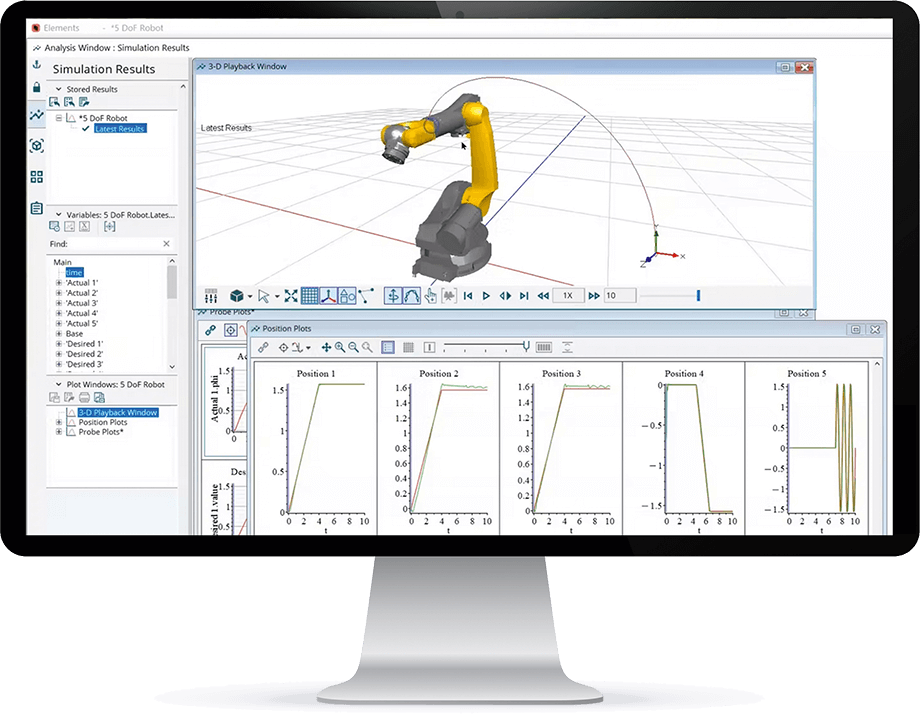Hexagon introduces Elements to help engineers design increasingly complex products with system-level modelling
1 December 2022

Hexagon’s Manufacturing Intelligence division has today introduced Elements, new simulation software that helps engineering teams understand the behaviour of systems that are becoming increasingly complex in modern products. Using the software, teams can evaluate the performance and feasibility of new design concepts quickly to inform more efficient product development and reduce risk and cost.
Elements addresses the growing importance of integrated, multi-disciplinary system development and end-to-end workflows. Customers in every industry are demanding technologies that consider many physics domains and tackle mechatronics challenges in a robust way, fuelling a growing trend towards system-level engineering. Achieving this requires the integration of all relevant engineering disciplines, control systems, and third-party supplier systems to understand how the domains interact, and how a design decision in one discipline impacts others.
Systems engineers can easily learn to use the Elements software, using its drag-and-drop environment to model any physics type or logic and analyse systems by intuitively connecting blocks – regardless of whether they represent electrical, hydraulic, mechanical components – to solve system-level engineering problems. It is based on the Modelica language, which is an open and widely used standard for building fast, flexible, and customisable models.
Systems modelling is indispensable in the early design phases because little information is required – often a CAD model, equation, or lookup table is sufficient and a 3D mesh is not required. Elements further speeds up engineering development because it also ensures that system-level models compute quickly and efficiently by optimising equations and code for fast calculation, but with no loss of fidelity.
As the design develops, and components and subsystems are detailed in specialist simulation software, the components can be routinely integrated into a larger system through full compliance with the FMI standard and Hexagon’s proprietary SmartConnect FMU technology. SmartConnect FMU unlocks the Functional Mock-up Unit (FMU) for supported Hexagon products so that changes can be made directly in the Elements system-level model without having to go back to the specialist Computer Aided Engineering (CAE) software and its expert user. This helps to avoid resource bottlenecks, time-consuming switching between applications, and versioning problems.
Hexagon’s roadmap will see its best-in-class CAE technologies readied for easy and productive use with Elements. At launch, the software provides SmartConnect FMU connectivity with Adams multibody dynamics software and Easy5. Future plans are likely to include workflows with Cradle CFD thermal-fluid dynamics and Actran acoustic simulation products, among others.
Both standard FMI support and the novel SmartConnect FMU plug-and-play capabilities offer immediate value and address challenges of system complexity, including those for transportation electrification; for example:
- Helping automotive engineers to find optimal solutions to vehicle range optimization issues by considering a vehicle’s energy use under different driving conditions, taking into account eDrive design, regenerative braking, climate control, ADAS safety requirements, and battery choice.
- Improving the flexibility and accuracy of industrial robotics by designing control systems that take detailed mechanical system vibrations and interactions from multi-body dynamics simulation into account.
- Right-sizing heavy battery systems in new eVTOL aircraft designs by helping engineers understand the power draw during take-off and landing, safety margins, and thermal management system controls.
- Implementing safer, more sustainable long-life battery systems by using Elements to design control systems that balance the improved performance of lithium-ion batteries at elevated temperatures with the impact heating has on cell degradation.
Elements was developed in close cooperation with Maplesoft, building upon its powerful maths engine to optimise system equations and deliver fast efficient simulation to Hexagon’s customers. Chris Harduwar, VP of Strategic Solutions at Maplesoft, commented: “We are excited to begin this long-term collaboration with Hexagon, which has an impressive vision and track record of innovation. By combining the tried-and-tested Maplesoft system-level modelling technology with the extensive Hexagon CAE portfolio, engineers in many industries benefit from new productivity-boosting solutions that significantly reduce simulation effort.”
Mahesh Kailasam, General Manager for Design and Engineering Software at Hexagon, commented, “Elements offers engineers an easy way to explore behaviour of systems quickly and find better solutions to problems using simulation, before committing designs to subsequent resource-intensive engineering processes. We look forward to a long-term collaboration with Maplesoft, using its powerful and open technology foundations to realise synergies with our extensive Hexagon CAE ecosystem portfolio and deliver valuable capabilities to our customers.”
To learn more about Elements, please visit hexagon.com/products/elements.
Media contacts:
Robin Wolstenholme
Global Media Relations and Analyst Relations Manager
Hexagon’s Manufacturing Intelligence Division
Phone: +44(0)7407 642190
e-mail: robin.wolstenholme@hexagon.com
Global press office: media.mi@hexagon.com
About Maplesoft
Maplesoft is a leading provider of high-performance software tools for engineering, science, and mathematics. Maplesoft Engineering Solutions provide advanced tools and services for system simulation, calculation management, and systems engineering, helping organisations maximise the power of their engineering knowledge so they can complete their projects quickly and successfully. The Maplesoft product suite includes Maple, the world’s most powerful math engine; Maple Flow, math software for engineering calculations; MapleSim, the advanced system-level modeling and simulation tool; and MapleMBSE, which supports a model-based systems engineering approach to requirements management. Maplesoft products and services are used in machine design, robotics, aerospace, automotive, industrial automation, and many other fields where engineers face complex challenges. Maplesoft is a subsidiary of Cybernet Systems Co. Ltd.
Hexagon is the global leader in digital reality solutions, combining sensor, software and autonomous technologies. We are putting data to work to boost efficiency, productivity, quality and safety across industrial, manufacturing, infrastructure, public sector, and mobility applications.
Our technologies are shaping production and people related ecosystems to become increasingly connected and autonomous – ensuring a scalable, sustainable future.
Hexagon (Nasdaq Stockholm: HEXA B) has approximately 24,500 employees in 50 countries and net sales of approximately 5.4bn EUR. Learn more at hexagon.com and follow us @HexagonAB.
